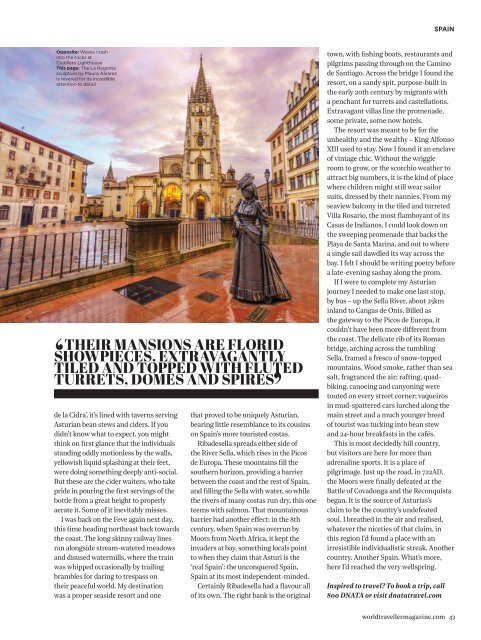Create successful ePaper yourself
Turn your PDF publications into a flip-book with our unique Google optimized e-Paper software.
SPAIN<br />
Opposite: Waves crash<br />
into the rocks at<br />
Cudillero Lighthouse<br />
This page: The La Regenta<br />
sculpture by Mauro Alvarez<br />
is revered for its incredible<br />
attention to detail<br />
‘<br />
THEIR MANSIONS ARE FLORID<br />
SHOWPIECES, EXTRAVAGANTLY<br />
TILED AND TOPPED WITH FLUTED<br />
TURRETS, DOMES AND SPIRES<br />
’<br />
de la Cidra’, it’s lined with taverns serving<br />
Asturian bean stews and ciders. If you<br />
didn’t know what to expect, you might<br />
think on first glance that the individuals<br />
standing oddly motionless by the walls,<br />
yellowish liquid splashing at their feet,<br />
were doing something deeply anti-social.<br />
But these are the cider waiters, who take<br />
pride in pouring the first servings of the<br />
bottle from a great height to properly<br />
aerate it. Some of it inevitably misses.<br />
I was back on the Feve again next day,<br />
this time heading northeast back towards<br />
the coast. The long skinny railway lines<br />
ran alongside stream-watered meadows<br />
and disused watermills, where the train<br />
was whipped occasionally by trailing<br />
brambles for daring to trespass on<br />
their peaceful world. My destination<br />
was a proper seaside resort and one<br />
that proved to be uniquely Asturian,<br />
bearing little resemblance to its cousins<br />
on Spain’s more touristed costas.<br />
Ribadesella spreads either side of<br />
the River Sella, which rises in the Picos<br />
de Europa. These mountains fill the<br />
southern horizon, providing a barrier<br />
between the coast and the rest of Spain,<br />
and filling the Sella with water, so while<br />
the rivers of many costas run dry, this one<br />
teems with salmon. That mountainous<br />
barrier had another effect: in the 8th<br />
century, when Spain was overrun by<br />
Moors from North Africa, it kept the<br />
invaders at bay, something locals point<br />
to when they claim that Asturi is the<br />
‘real Spain’: the unconquered Spain,<br />
Spain at its most independent-minded.<br />
Certainly Ribadesella had a flavour all<br />
of its own. The right bank is the original<br />
town, with fishing boats, restaurants and<br />
pilgrims passing through on the Camino<br />
de Santiago. Across the bridge I found the<br />
resort, on a sandy spit, purpose-built in<br />
the early 20th century by migrants with<br />
a penchant for turrets and castellations.<br />
Extravagant villas line the promenade,<br />
some private, some now hotels.<br />
The resort was meant to be for the<br />
unhealthy and the wealthy – King Alfonso<br />
XIII used to stay. Now I found it an enclave<br />
of vintage chic. Without the wriggle<br />
room to grow, or the scorchio weather to<br />
attract big numbers, it is the kind of place<br />
where children might still wear sailor<br />
suits, dressed by their nannies. From my<br />
seaview balcony in the tiled and turreted<br />
Villa Rosario, the most flamboyant of its<br />
Casas de Indianos, I could look down on<br />
the sweeping promenade that backs the<br />
Playa de Santa Marina, and out to where<br />
a single sail dawdled its way across the<br />
bay. I felt I should be writing poetry before<br />
a late-evening sashay along the prom.<br />
If I were to complete my Asturian<br />
journey I needed to make one last stop,<br />
by bus – up the Sella River, about 25km<br />
inland to Cangas de Onís. Billed as<br />
the gateway to the Picos de Europa, it<br />
couldn’t have been more different from<br />
the coast. The delicate rib of its Roman<br />
bridge, arching across the tumbling<br />
Sella, framed a fresco of snow-topped<br />
mountains. Wood smoke, rather than sea<br />
salt, fragranced the air; rafting, quadbiking,<br />
canoeing and canyoning were<br />
touted on every street corner; vaqueiros<br />
in mud-spattered cars lurched along the<br />
main street and a much younger breed<br />
of tourist was tucking into bean stew<br />
and 24-hour breakfasts in the cafés.<br />
This is most decidedly hill country,<br />
but visitors are here for more than<br />
adrenaline sports. It is a place of<br />
pilgrimage. Just up the road, in 722AD,<br />
the Moors were finally defeated at the<br />
Battle of Covadonga and the Reconquista<br />
began. It is the source of Asturias’s<br />
claim to be the country’s undefeated<br />
soul. I breathed in the air and realised,<br />
whatever the niceties of that claim, in<br />
this region I’d found a place with an<br />
irresistible individualistic streak. Another<br />
country. Another Spain. What’s more,<br />
here I’d reached the very wellspring.<br />
Inspired to travel? To book a trip, call<br />
800 DNATA or visit dnatatravel.com<br />
worldtravellermagazine.com 43

















